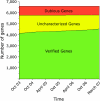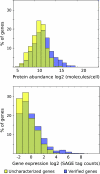Why are there still over 1000 uncharacterized yeast genes?
- PMID: 17435240
- PMCID: PMC1893027
- DOI: 10.1534/genetics.107.074468
Why are there still over 1000 uncharacterized yeast genes?
Abstract
The yeast genetics community has embraced genomic biology, and there is a general understanding that obtaining a full encyclopedia of functions of the approximately 6000 genes is a worthwhile goal. The yeast literature comprises over 40,000 research papers, and the number of yeast researchers exceeds the number of genes. There are mutated and tagged alleles for virtually every gene, and hundreds of high-throughput data sets and computational analyses have been described. Why, then, are there >1000 genes still listed as uncharacterized on the Saccharomyces Genome Database, 10 years after sequencing the genome of this powerful model organism? Examination of the currently uncharacterized gene set suggests that while some are small or newly discovered, the vast majority were evident from the initial genome sequence. Most are present in multiple genomics data sets, which may provide clues to function. In addition, roughly half contain recognizable protein domains, and many of these suggest specific metabolic activities. Notably, the uncharacterized gene set is highly enriched for genes whose only homologs are in other fungi. Achieving a full catalog of yeast gene functions may require a greater focus on the life of yeast outside the laboratory.
Figures





Similar articles
-
Qualitative evidence synthesis informing our understanding of people's perceptions and experiences of targeted digital communication.Cochrane Database Syst Rev. 2019 Oct 23;10(10):ED000141. doi: 10.1002/14651858.ED000141. Cochrane Database Syst Rev. 2019. PMID: 31643081 Free PMC article.
-
Depressing time: Waiting, melancholia, and the psychoanalytic practice of care.In: Kirtsoglou E, Simpson B, editors. The Time of Anthropology: Studies of Contemporary Chronopolitics. Abingdon: Routledge; 2020. Chapter 5. In: Kirtsoglou E, Simpson B, editors. The Time of Anthropology: Studies of Contemporary Chronopolitics. Abingdon: Routledge; 2020. Chapter 5. PMID: 36137063 Free Books & Documents. Review.
-
Falls prevention interventions for community-dwelling older adults: systematic review and meta-analysis of benefits, harms, and patient values and preferences.Syst Rev. 2024 Nov 26;13(1):289. doi: 10.1186/s13643-024-02681-3. Syst Rev. 2024. PMID: 39593159 Free PMC article.
-
Using Experience Sampling Methodology to Capture Disclosure Opportunities for Autistic Adults.Autism Adulthood. 2023 Dec 1;5(4):389-400. doi: 10.1089/aut.2022.0090. Epub 2023 Dec 12. Autism Adulthood. 2023. PMID: 38116059 Free PMC article.
-
Trends in Surgical and Nonsurgical Aesthetic Procedures: A 14-Year Analysis of the International Society of Aesthetic Plastic Surgery-ISAPS.Aesthetic Plast Surg. 2024 Oct;48(20):4217-4227. doi: 10.1007/s00266-024-04260-2. Epub 2024 Aug 5. Aesthetic Plast Surg. 2024. PMID: 39103642 Review.
Cited by
-
Genome-wide Fitness Profiles Reveal a Requirement for Autophagy During Yeast Fermentation.G3 (Bethesda). 2011 Oct;1(5):353-67. doi: 10.1534/g3.111.000836. Epub 2011 Oct 1. G3 (Bethesda). 2011. PMID: 22384346 Free PMC article.
-
Using HHsearch to tackle proteins of unknown function: A pilot study with PH domains.Traffic. 2016 Nov;17(11):1214-1226. doi: 10.1111/tra.12432. Epub 2016 Oct 9. Traffic. 2016. PMID: 27601190 Free PMC article.
-
Meta-Research: understudied genes are lost in a leaky pipeline between genome-wide assays and reporting of results.bioRxiv [Preprint]. 2024 Feb 5:2023.02.28.530483. doi: 10.1101/2023.02.28.530483. bioRxiv. 2024. Update in: Elife. 2024 Mar 28;12:RP93429. doi: 10.7554/eLife.93429. PMID: 36909550 Free PMC article. Updated. Preprint.
-
Darkness in the Human Gene and Protein Function Space: Widely Modest or Absent Illumination by the Life Science Literature and the Trend for Fewer Protein Function Discoveries Since 2000.Proteomics. 2018 Nov;18(21-22):e1800093. doi: 10.1002/pmic.201800093. Epub 2018 Oct 30. Proteomics. 2018. PMID: 30265449 Free PMC article.
-
Yeast evolutionary genomics.Nat Rev Genet. 2010 Jul;11(7):512-24. doi: 10.1038/nrg2811. Nat Rev Genet. 2010. PMID: 20559329 Review.
References
-
- Alexandrov, A., I. Chernyakov, W. Gu, S. L. Hiley, T. R. Hughes et al., 2006. Rapid tRNA decay can result from lack of nonessential modifications. Mol. Cell 21: 87–96. - PubMed
-
- Bader, G. D., A. Heilbut, B. Andrews, M. Tyers, T. Hughes et al., 2003. Functional genomics and proteomics: charting a multidimensional map of the yeast cell. Trends Cell Biol. 13: 344–356. - PubMed
-
- Blandin, G., P. Durrens, F. Tekaia, M. Aigle, M. Bolotin-Fukuhara et al., 2000. Genomic exploration of the hemiascomycetous yeasts: 4. The genome of Saccharomyces cerevisiae revisited. FEBS Lett. 487: 31–36. - PubMed
Publication types
MeSH terms
LinkOut - more resources
Full Text Sources
Other Literature Sources
Molecular Biology Databases

